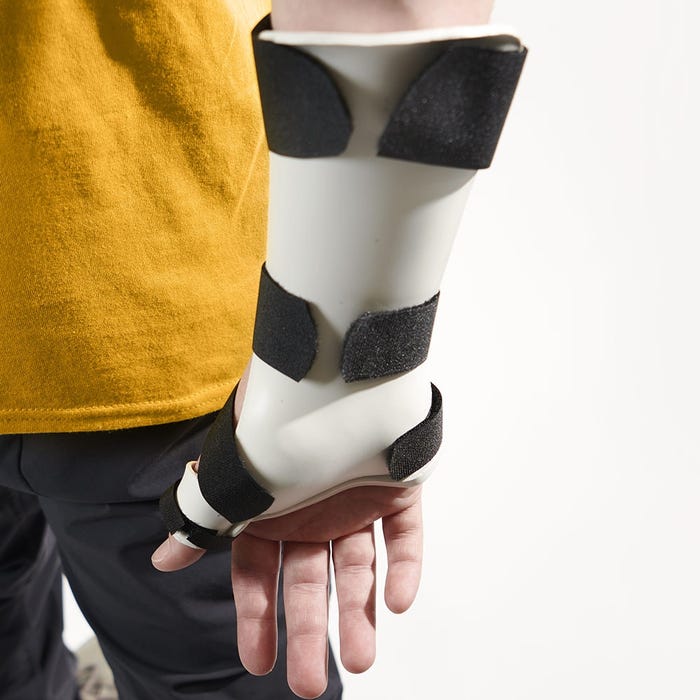Rolyan Polyflex II Thermoplastic Splinting Material
-

This item is considered as a dimensionally oversized parcel and will incur additional freight & handling charges, that will be advised by Customer Service after your order is placed.
-
If you have any questions please contact Customer Service on 1300 473 422 or email sales@performhealth.com.au
- Features a high conformability and low resistance to stretch
- Provides outstanding natural drape and excellent strength
- Can be reheated and reshaped, but won’t return to original shape
- Splinting material is non-toxic, latex-free, and radiolucent
PolyFlex II Overview
Polyflex II™, the second iteration of Polyflex, is a polycaprolactone-based splinting material that offers a balanced combination of high conformability and low resistance to stretch. It provides outstanding natural drape — just less than Polyform — and ease of moulding. This makes it an excellent choice for splints that require a precise fit. Although it has a low resistance to stretch, Polyflex II still has excellent strength, rigidity and flexibility when cooled.
Polyflex II has a water-based, non-stick coating, which prevents accidental bonding. It can be reheated and reshaped repeatedly, but once it has been stretched, it will not return to its original shape. Polyflex is non-toxic, latex-free and radiolucent. It’s recommended for finger and hand splints, dynamic splints, neck collars, and more.
Key Material Benefits
Polyflex II is the only Rolyan splint that is flexible enough when cooled to directly resist stress fatigue. It will resist the start and spread of cracks caused by high load flexing of the splint, making it the ideal choice for splints used in a heavy work environment.
Handling Characteristics
Resistance to stretch: Minimum
Stretches easily when heated and only requires soft, gentle pressure to form a splint, allowing clinicians to have excellent control. Be careful not to allow material to stretch too much.
Conformability: Maximum
Easily conforms to surface contours and detail, reducing time to fabricate splint, and provides a precise fit for increased comfort and fewer pressure areas. High degree of drape.
Memory: Minimum
Ability to be reheated and reshaped but will not return to original shape.
Bonding: Coated
Create a temporary bond by pinching together heated material; however, it will come apart when cooled. Form a permanent bond by scrubbing off the coating or removing it with a bond solvent.
Physical Characteristics
Colours: Assorted
White, beige or blue
Thickness: Assorted
Available in the following sheet thicknesses: 1/8" (3.2mm), 1/16" (1.6mm) and 3/32" (2.4mm). Suitable for larger fracture braces or intricate paediatric splints.
Perforations: Assorted
Available in 1 percent or solid material.
Appearance: Opaque when heated
Hardened Splint Characteristics
Rigidity: Moderate (49.8 kpsi*)
Retains shape without reinforcement.
*Refers to Young’s Modulus testing value
Surface: Smooth
Picks up fingerprints and markings if not properly handled.
Heating Instructions
The recommended method for heating splinting materials is with hot water in a splint bath. A heat gun should only be used for spot-heating and adjustments.
| Material thickness | Approximate heating time | Water temperature:: Celcius | Working Time |
| 1.6 mm (1/16") | 30 sec | 65° - 70° | 1 min |
| 2.4 mm (3/32") | 30 - 45 sec | 65° - 70° | 2 - 3 min |
| 3.2 mm (1/8") | 1 min | 65° - 70° | 3 - 5 min |
Note: Overheating splinting materials increases the draping/stretching characteristics; allow material to cool slightly before handling to avoid excess stretching.
Indications
Splinting materials are intended to be used for fabrication of custom moulded rigid splints, orthoses, and adaptive equipment.
Best uses include:
- Thumb splints
- Finger splints
- Hand splints
- Wrist splints
- Elbow splints
- Dynamic splints
- Neck collars
- Foot drop splints
- Carpal tunnel splints
- Paediatric splints
- Adaptive equipment
- Fracture braces
- Splints for arthritis
- Knee splints
- Flexor tendon repair splints
| Brand | Rolyan |
|---|
- Features a high conformability and low resistance to stretch
- Provides outstanding natural drape and excellent strength
- Can be reheated and reshaped, but won’t return to original shape
- Splinting material is non-toxic, latex-free, and radiolucent



 US
US France
France


